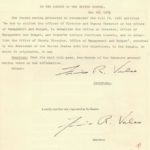As they framed the Constitution, many of the Founding Fathers were wary of a powerful chief executive who might overshadow the legislative branch. By constructing the separation of powers within the federal government with a system of checks and balances, the Framers sought to limit the power of the president. Students will investigate not only the formal checks as laid out in the Constitution, but also explore the informal checks on presidential power that have emerged in the modern era. Free registration required to access lesson plan.
Grade 6-8 An Energetic Executive
The purpose of this lesson is to assist student understanding of the expressed and implied powers of the president. By the conclusion of this lesson, students will understand the scope and purpose of these powers and be able to describe how they play out in real life. Students will also understand the importance of constitutional checks on presidential powers–examining the ways that a president could abuse his or her power should constitutional checks not exist.
Election: The Road to the White House (Secondary)
During an election, civic energy reaches a fever pitch. The vote is one of the citizen’s most powerful tools, and advocating for a candidate, a set of ideas, or a platform is the right of every citizen. The President of the United States is often called the most powerful person in the world, so with every presidential election, the stakes are high. This unit is designed to teach students about presidential elections. It is not a collection of facts, diagrams, and explanations of processes. It is an interactive, project-based unit that invites the student to fully engage in the process of an election while also informing students about how elections work. It is our hope that this unit helps cultivate the sorts of informed and engaged citizens that are so essential to our democracy.
Presidential Signing Statements
Executive Power in Times of Crisis
This lesson explores the use of executive power in times of crisis in relation to both the Constitution and the legislation of the time. Using exclusive primary source material from the National Archives at the Ronald Reagan Presidential Library, students will explore how President Lincoln, President Reagan, and President Obama utilized their executive power against the respective threats of their time.
Congress at Work: The Presidential Veto and Congressional Veto Override Process

Students will use a facsimile of a vetoed bill and veto message to understand the veto and veto override process in Congress. Referring to the Constitution, students will match the Constitution’s directions to the markings and language of the bill and veto message. Students will then investigate motives for using the veto and override powers, and how the powers reflect the Constitution’s checks and balances.
The Constitutional Convention: Creating an Executive
History is the chronicle of choices made by actors/agents/protagonists in specific contexts. This simulation places students at the Constitutional Convention and asks them to explore one of the fundamental quandaries faced by the framers: how to create an executive branch that lacked monarchical prerogatives yet could make the government function more efficiently. By discussing and debating the various options, students will gain a deeper understanding of the choices the framers faced and why they opted for particular structures, ones we live with today.
Constitutional Index – Commander in Chief Clause
The Constitutional Index breaks down the U.S. Constitution by Section, Amendment, and Clause and contains broader topics and themes. These are used to cross-reference Library resources in an effort to annotate constitutional history.
The Appointment of Sandra Day O’Connor
The U.S. Constitution grants the President the power to appoint people to a variety of government positions. These appointments require careful thought and consideration since the people can have a great impact on the lives of many Americans during that President’s term. Some appointments need even greater thought and consideration, and those are to the federal judicial system and more importantly, to the Supreme Court of the United States. Justices of the Supreme Court (and other federal courts) serve lifetime appointments. Their rulings as they interpret the Constitution, and other situations as outlined in Article III of the Constitution, can have far-reaching effects for generations. With this awesome power to appoint comes an equally awesome responsibility to make sure that the individuals are the best people for the job. In this lesson, students will examine the appointment of Supreme Court Justice Sandra Day O’Connor, who was also the first female Justice. Students will examine the process by which a President makes the selection and the steps that lead to that person being confirmed by the Senate (or not).
Harnessing the Political Power of Words
Presidential candidates know that it’s not just what you say, but how you say it. Advisers and speechwriters shape their statements for maximum effect.
